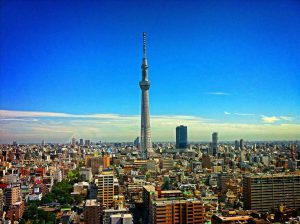Last Thursday evening, Tokyo was rocked by the strongest earthquake in 10 years, which injured 54 people, paralyzed public transport, and caused water and power outages. It gave a glimpse of the urban impact of a massive earthquake and ignited fears of a megaquake that could strike directly under Tokyo, some predicted to happen within 30 years.
While earthquakes are a regular occurrence in Japan, they rarely hit the capital.
But since 2013 authorities have warned residents in the capital to make preparations against the “big one.” A government report detailed a 70 percent possibility of a violent magnitude 7.9 mega earthquake beneath Tokyo, with a shallow epicenter of 30 to 40 kilometers. Such an event would be expected to cause tremendous damage to infrastructure and essential services. Authorities also have also emphasized post-earthquake threats unique to urban areas such as falling concrete as well as food, power, and water shortages on account of the high density of water pipes and infrastructure.
Tokyo is the world’s most densely populated metropolis. Since the magnitude 9 Great East Japan Earthquake on March 11, 2011, which took the lives of over 20,000 people, Tokyo has made efforts to improve disaster communication, including evacuation drills. It has also been phasing out old residential wooden and wood frame houses with earthquake and fire-resistant standards.
However, Thursday’s magnitude 5.9 earthquake, which struck in northwestern Chiba prefecture at 10:41 p.m., was a bleak reminder of the potential future. In Tokyo skyrise buildings could be seen swaying for 40 seconds. Meanwhile, three carriages of a driverless train derailed, injuring three people. Hundreds of passengers in another train were forced to evacuate by ladder in the early hours of the morning after being stranded on board for hours. Local municipalities in Tokyo opened shelters for passengers unable to return home. Train disruptions continued into the next day and in Chiba prefecture, part of Greater Tokyo, crowds of hopeful commuters could be seen waiting in lines that stretched from the train platform onto the street.
The Japan Meteorological Agency (JMA) warned of another similar size earthquake in the coming week and urged residents to make preparations to secure furniture and wall fixtures. Public concerns as to whether the earthquake was a precursor to the feared “big one” were dispelled, however, as the epicenter of last week’s earthquake was 75 kilometers deep and occurred on a reverse fault between the Pacific plate and Philippine Sea plate. In general, quakes here do not cause tsunamis.
The megaquake predicted in Tokyo would be 30 times bigger with an epicenter expected to be shallow, which would lead to incomparable damage.
The government report highlighted that a worst-case scenario would be a megaquake striking on a windy evening during winter, which would fan the spread of multiple fires and cause major loss of life. An estimated 23,000 people could lose their lives, 70 percent as a result of fires. The report predicted that approximately 2,000 incidents of fire could break out simultaneously under that scenario, which the city’s 700 fire trucks would not be able to tackle in the early stages. Large-scale fires could burn for an extended period of time as fire trucks would be unable to rush to the scene due to intense traffic congestion. As many as 610,000 houses could be damaged and the overall economic damage is estimated at 95 trillion yen.
To make matters worse, the disruption of public transport after a megaquake is likely to leave millions of workers stranded in densely packed business hubs across Tokyo. In the aftermath of the 3/11 Great East Japan Earthquake people were forced to make the grueling journey home on foot. But in the event of the anticipated megaquake, the government report highlights the risk that people will walk straight into multiple fires.
Japan is also bracing for another possible deadly megaquake in the Nankai Trough, a submarine trench off Japan’s Pacific coast. The government warned that a large quake here would lead to a national crisis. A cabinet office report highlighted that a tsunami higher than 10 meters could strike Japan’s southeastern prefectures of Shizuoka, Mie, Kochi, and Wakayama and cause a death toll of 231,000 in a worst-case scenario.
In the Nankai Trough, magnitude 8 earthquakes occur every 100 to 200 years. But current seismology technology cannot predict when the next massive earthquake will hit.

































